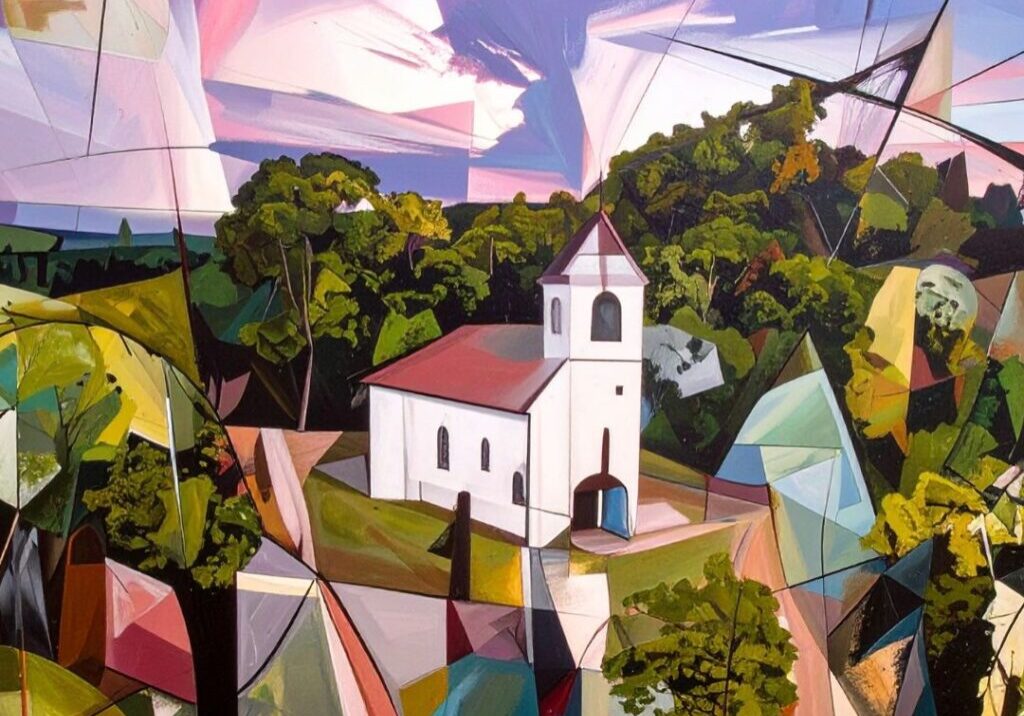New Wine Needs New Wineskins
The United States Catholic Conference of Bishops recently concluded their annual meeting by advancing a document on reception of the Eucharist for pro-choice Catholic politicians. The decision to produce such a document revealed the deep fissure of theological positions among U.S. Bishops. There are many dimensions to this discussion; however, for the purpose of my blog I want to limit my remarks to the need for a new theology, one that aligns with our current understanding of cosmology, evolution and quantum physics. Without such a shift, ideological conflicts will likely deepen in the Church, eventually causing an implosion. Notwithstanding the separation of Church and State, the Church will continue to struggle with a seamless ethic of life primarily because it insists on holding on to universal principles formulated centuries ago, when cosmic life was considered static and fixed. Since the nineteenth century, the principles of evolution have governed science. Evolution is no longer a theory but a reliable description of nature that undergirds all aspects of life, including culture and religion. While evolution is a global phenomenon, the processes of evolution are local. Nature works in tandem with the environment. On the level of matter, quantum physics indicates that matter and energy are two forms of the same stuff in which indeterminacy defines interconnected and mutually interacting energy fields. On higher levels of biology, relationships undergird structures in which information is shared through cybernetic loops in openness to the surrounding environment. In the world of natural processes, all life is local, so that “universal” principles are local principles operating in particular environments.
The Church has held an ambiguous relationship to science since the rise of modernity and the discovery of Darwin’s evolution. In 1879, amidst the tailwinds of evolution, Pope Leo XIII mandated that the theology of St. Thomas Aquinas be taught as the official theology of the Church. With a universal theology formulated by a brilliant medieval theologian, the Church could withstand the challenges of modern science. In the twentieth century, Pope Pius XII opened a door to evolution in his 1950 encyclical Humani generis, indicating that the body may develop by way of evolution, but the soul is created immediately by God. Evolution was not incorporated into preaching or liturgical life, because it was considered a theory in need of validation. The Church anchored ecclesial life in the firm foundation of the medieval theology of Thomas Aquinas. The documents of Vatican II evoked new branches of theology to form but no new theology has replaced the tree of Thomas Aquinas. As such, we have a medieval Church in a posthuman world.
While the Church made significant efforts to embrace modern science in the twentieth century, noted by the Vatican’s support of the religion and science dialogue, it has yet to incorporate insights from modern science into theological doctrine and liturgical life. The Church’s theology is taught and preached as a theology formed in the ancient Ptolemaic cosmos. Yet, as Raimon Panikkar wrote, a theology separated from a credible cosmology is no theology at all; at best, it is history. In his Gifford lectures, Panikkar wrote:
“The very name of God is a cosmological notion. God is God for the world, the Creator is creator of the creation . . .God has a cosmological dimension just as the cosmos has a divine aspect. In short, a theology without cosmology is a mere abstraction of a non-existing God; and a cosmology without theology is a mirage. Cosmology and theology are intrinsically knit together” (p. 187-88).
In 2015 Pope Francis’s issued his encyclical, Laudato Si’, in which the Church opened a window to the crisis of the environment and the struggle of the poor. It is a noble document that calls for a change in human relationships toward a more equitable and sustainable earth. However, the theology of Laudato Si’ is essentially medieval in content, replete with a metaphysics of participation. Without fully embracing modern science, the Church maintains ontological distinctions between God and creation which results in epistemological knots. As the Pope writes, there are two books of revelation, nature and scripture, two realities, creation and nature, two forms of human life, evolution and special creation (the human as image of God), two views of God and world, original sin and evolution, and a number of other theological knots. Unfortunately, Laudato Si’ offers nothing more than another voice, among thousands, calling attention to the dire consequences of global warming. Its heart is in the right place, but it offers no new theological paradigm, no vision of how the Church can model a primal sacred community. Laudato Si’ wants the world to live in radical interdependence while the contentious U.S. Catholic Bishops Conference shows a Church that is theologically fractured.
We are in a weary world today, worn down by a lingering pandemic and desperate for signs of new life. Many people are preoccupied by existential concerns: income, job security, family, health and education. Even if they attend Church, they are deaf to what the Church is saying about the environment. Our theological limping with a medieval cane is shown in the persistence of “unsatisfied theism.” According to a 2019 Gallup poll, Church membership continues to decline, especially among Catholics, while those identifying as “spiritual but not religious” continues to rise, particularly among millennial, Gen X, Y and Z generations (https://news.gallup.com/poll/248837/church-membership-down-sharply-past-two-decades.aspx).
The Church has lost credibility; it is a voiceless voice in a world struggling to find a new voice of planetary life. The most significant changes in culture today are not due to the Catholic Church but to posthumanist and new materialist thinkers who are redefining materiality, personhood and ethics. If the Church is to do more than merely survive, we need a new theological vision, a new religious spirit, one that animates our lives, draws us into community and instills a zest for all planetary life. Thomas Berry, in his 1989 essay on “the Christian future and the Fate of the Earth,” insightfully noted that “the ecology movement exists in its own right. It has inherently religious dimensions. It does not need biblical verification or consecration. Those committed to care of the earth are fulfilling a sacred task.” One does not need to be Catholic to be committed to environmental sustainability. It has become a religious calling in its own right.
There is a type of sacred secularity that has been emerging since the late twentieth century. A religious imaginary is how we imagine or envision God, humanity and planetary life. To change the religious imaginary is to change the way we tell the story about religion, including its beliefs and practices. The new science, with evolution and quantum physics as the primary pillars, has evoked a new religious consciousness of interrelatedness, a new sense of wholeness, and a new understanding of life in evolution. The 21st century is the emergence of a new religious imaginary. As Teilhard noted long ago, there is communion with God, communion with the earth, and communion with God through the earth. In the 21st century, to be religious is to be devoted to care for the earth and care for the poor, whether or not, one prays or goes to daily Mass. God is worthy of our worship and worship is how we devote ourselves to God and express our commitments. To hide in the pews of a Church without care for the earth is to pray before an empty tabernacle.
To be involved with the earth is itself a religious dimension of life, a form of prayer. Contemplation is no longer simply withdrawing from the world and ascending to God; now it is expressed in action for social justice, for the equality of races, the inclusion of all genders, attention to the extinction of species, practices of restraint in the name of global warming. To “ascend” to God is to move toward God, who is no longer in a spiritual plane “above”; in the new religious imaginary, God is among and between, around and within, a God who calls us from the material world to listen to the groans of matter, to be formed by the movements of matter and to act as if matter really matters. Teilhard de Chardin said we are saved by becoming one with the universe. Heaven, therefore, is no longer a place “above” earth; it is what earth can become if we are devoted to its care. To work out our salvation is to be committed to care for the earth, that is, all creaturely life, including humans; to aim for heaven is to devote oneself to the wholeness of planetary life. This is not pantheism; this is Christian realism in a world of evolution and quantum physics.
The Church is working out of an old religious imaginary, a medieval imaginary where the static microcosm and macrocosm were held together in a complementary relationship by the Creator God. In the old paradigm, matter was not a form of energy, and mind was not part of matter, which allowed the Church to distinguish between evolution of the body and evolution of the soul. Operating out of this paradigm, evolution has nothing to do with “creation” itself. Creation is the term that describes the miracle of existence in general. Evolution is simply the “making” and “ordering” of creation. The act of creation gathers into one single divine moment the whole of existence, even though this existence is itself extended in time and differentiated. There is in principle no contradiction between creation and evolution because, for the Church, these concepts belong on different levels.
“The reason for Christian aversion to the story of an emergent universe,” Thomas Berry wrote, “is that the story has generally been told simply as a random physical process when in reality it needs to be told as a psychic-spiritual as well as a physical-mental process from the beginning. . . .The universe story, the earth story, the life story and the human story are all a single story.” He went on to say, “we are so integral with the world about us that we might consider the universe itself as the larger dimension of our own being. We, in turn, enable the universe to reflect on and celebrate itself and its numinous origin in a special mode of self-awareness.” Hence, Berry concludes, there are not two stories, religious and scientific, there is only one story, the Great Story. In a world of quantum reality, nothing is itself without everything else; there is no separation. The universe is a single, multiform reality.
A world of true interdependence wherein humans form a single community with all the other living beings that exist upon the earth calls for new forms of worship and new levels of action. If the Church is to survive, it will need to relinquish its medieval theological grasp. We humans are simply not that special, and we may be replaced by super intelligent machines in the future if we continue to ignore the cries of the earth and the cries of the human heart in search of a living God. The ultimate concern of the human must be the integrity of the universe upon which the human depends in an absolute manner. God is rising up in and through the dynamic processes of life; the glory of God is realized in the creativity of life, for where there is harmony, goodness and beauty of life, there is God. To be religious today is to be committed to the unity of planetary life, the continuity of the non-human with the human, the development of principles in all our human institutions, –including schools and places of worship–professions, programs and activities that can effectively bring healing to our damaged planet. The medieval Church is over.If the Church is to have an effective voice in the world, then we need a theological revolution, including new forms of worship and practice, a Church that lives a theology of “deep incarnation,” perhaps realizing the full implications of the incarnation for the first time since the Christ event. This is the heart of the Gospel: the end is in the beginning, and the beginning is always new.
 View print-friendly version
View print-friendly version
47 Comments
Related Posts

Mission for an Evolutionary Christianity
We are living through tumultuous times. Political polarization intensifies, violence against vulnerable populations escalates, and the foundational principles of human dignity face erosion. For many, the cognitive dissonance between professed…


As always, mind blowing, but blowing away all the old cobwebs!
From your lips to God’s ear.
Thank you Sister Delio !!! It’s Inspiring People like you Father Rohr, David Benner and others that keep Religion Alive for myself and I’m sure millions of others. Thanks again for your Inspiring Work and Message !!!
Would that the powers who be within the Catholic Church hierarchy had the perspective and will to be able to hear and act upon what Ilia writes here and elsewhere!
The universe brought the human species into existence through evolutionary processes. Although we are the universe reflecting on itself, we are still only one species among many and our sense of being superior as a species that has led to mass extinctions at a rate never before precedented. I imagine that theoretically it will be possible to produce machines that are able to produce and repair ever more sophisticated machines – not that I think or hope. that will be the future in place of humans. Ilia has written several books that “put some meat on those bones”.
Thank you Illia you are a prophet of thec21 st century. God Bless You.
Very well stated, Ilia. Our institutional Church is in great need of a more self-aware theology that enables transition from its Medieval shackles. Your concluding paragraph sums this up, and reminds me of the famous quote from TS Eliot: “We shall not cease from exploration, and the end of all our exploring will be to arrive where we started and know the place for the first time.”
Thank you Jack for your comments. I fully resonate with what you have pointed out.
Thanks so much, again Ilia. Your clarity and courage to lead us on this path is so needed. I’m sending your words on. much love,
I talked to a seminarian Sunday. He was in first theology, a pre-theology program steeped in Greek philosophy that is two years in length which precedes four years of theology. It is intended to educate his thought process so that he can understand and defend the hoard of Roman Catholic theologies, like “ontological change,” based on the teachings of a 13th century theologian drawing upon the understanding of reality embraced by 4th and 5th century BC Greek philosophers. What if, instead, they spent two years studying basic physics, systems theory, emergent behavior, and the like, to try to understand what God was revealing in God’s creation? Mightn’t that enable them to better understand what Paul was saying when he told us, “There is neither Jew nor Greek, slave nor free, male nor female, for you are all one in Christ Jesus,” better enlightening us as to who can serve “in persona Christi,” for instance?